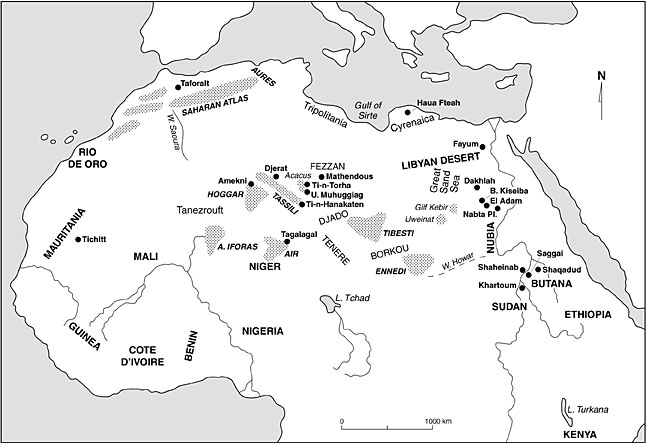

 | Page 44 |  |
era of the explorers, whether adventurers or scientists. The discipline of Saharan prehistoric archaeology had been founded.

Saharan Archaeological Sites
At the beginning of the twentieth century the French penetrated more deeply into the Hoggar. However, archaeological research in French-speaking Africa concentrated almost wholly on the Maghreb until 1920 to 1930. There, rich historical civilizations and prehistoric cultures were found that looked similar to European ones. They were studied in the same way, with the same words, and with the same goal of organizing the finds into sets of synchronous elements that constituted “stages,” analogous with geological and paleontological stages. Then the stages were ordered into chronological sequences. Later on Saharan archaeology was built upon the same fundamental concepts. The first things looked for were the links with Maghreb cultures and the influence, thought to be evident, of pharaonic civilization.
The rock art of the Saharan Atlas was the topic of the first synthesis by G.B. Flamand, Les Pierres Ecrites (“Engraved Stones”) published after his death in 1921. The classification it proposed is crude: an earlier group in naturalistic style, called “prehistoric,” but already recognized as “Neolithic,” and a later group in schematic style, called “libyco-berber,” with pictures of horses, camels, and inscriptions in the Libyan alphabet. These two groups, which were later named “Precameline” and “Cameline,” constituted the fundamental frame of reference for all Saharan classifications.
In 1925 another important work appeared—L. Frobenius and h. obermaier’s Hadschra Maktouba, which focused on the engravings of the Saharan Atlas. Frobenius was searching Africa for proof of the “Hamitic hypothesis,” although neither he nor anybody else ever found it. This theory, developed by C.G. Seligman and others, was in vogue at the time and held that “civilization” had been diffused south of the Sahara (read in the Africa of the Negroes) by either the oriental or northern Hamites, who were pastoral
 |  |